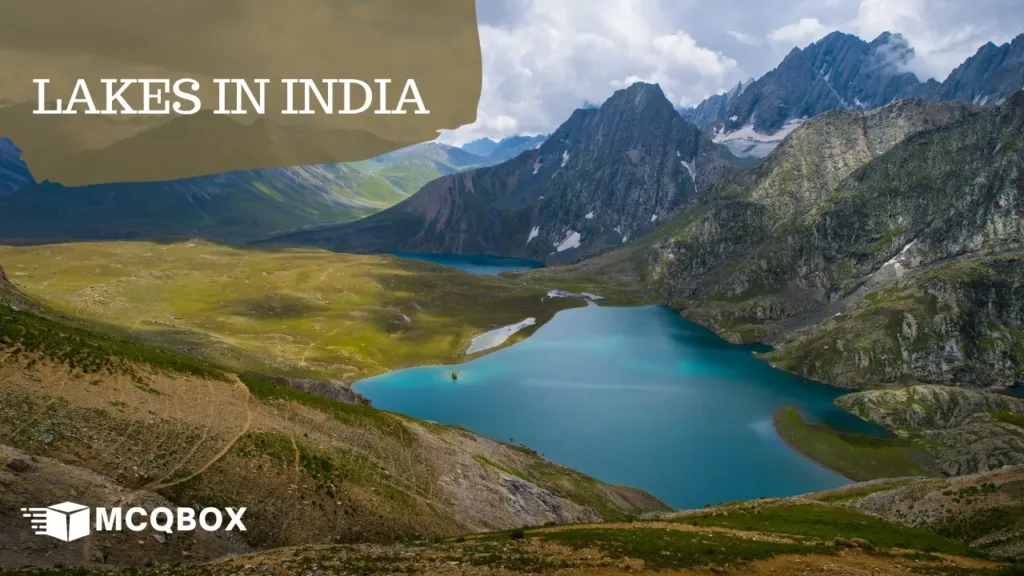Dive deep into the geography of India with this comprehensive list of Lakes in India, perfect for competitive exam preparation. Enhance your knowledge now!
Table of Contents
Introduction
India, a land of diverse landscapes, boasts an array of water bodies, including lakes that play a crucial role in the nation’s ecology. From natural wonders to human-made reservoirs, India’s lakes come in various types, each with its unique characteristics and significance.
Types of Lakes in India

Freshwater Lakes
Freshwater lakes in India, such as the majestic Wular Lake in Jammu and Kashmir, hold unsalted water. Fed by rivers, streams, and runoffs, these lakes contribute to the rich biodiversity of the regions they inhabit.
Saltwater Lakes
On the flip side, saltwater lakes like the renowned Sambhar Lake in Rajasthan boast high concentrations of salts. These lakes provide a unique habitat for flora and fauna adapted to saline environments.
Artificial Lakes
Artificial lakes, a testament to human ingenuity, serve the purpose of water storage for public use. Chembarambakkam Lake in Tamil Nadu stands as a prime example of how man-made reservoirs contribute to water management.
Oxbow Lakes
Nature’s artistry is showcased in oxbow lakes, formed when a river alters its course, leaving behind a meander that evolves into a tranquil lake. Chandubi Lake in Assam exemplifies the beauty of these natural formations.
Crater Lakes
Crater lakes, born from the aftermath of volcanic eruptions, reveal the Earth’s geological history. Lonar Lake in Maharashtra stands as a testament to the explosive forces that shape our landscapes.
| State/UT | Lakes in India |
| Andhra Pradesh | Pulicat lake |
| Andhra Pradesh | Kolleru Lake |
| Assam | Haflong Lake |
| Assam | Deepor Beel |
| Assam | Chandubi Lake |
| Bihar | Kanwar lake |
| Gujarat | Hamirsar Lake |
| Gujarat | Kankaria Lake |
| Haryana | Badkhal Lake |
| Haryana | Brahma Sarovar |
| Himachal Pradesh | Chandra Taal |
| Himachal Pradesh | MaharanaPratap Sagar |
| Jammu Kashmir | Dal Lake |
| Jammu Kashmir | Wular Lake |
| Karnataka | Agara Lake |
| Karnataka | Ulsoor Lake |
| Kerala | Kuttanad Lake |
| Kerala | Sasthamkotta |
| Madhya Pradesh | Bhojtal |
| Maharashtra | Shivsagar |
| Manipur | Loktak lake |
| Meghalaya | Umiam Lake |
| Mizoram | Tam Dil |
| Odisha | Chilika Lake |
| Punjab | Harike |
| Punjab | Kanjli |
| Rajasthan | Sambhar Lake |
| Sikkim | Tsomgo Lake |
| Tamil Nadu | Chembarambakkam |
| Tamil Nadu | Kaliveli |
| Telangana | Hussain Sagar |
| Uttar Pradesh | Govind Bhallabh Pant Sagar |
| Uttar Pradesh | Belasagar |
| Uttarakhand | Bhimtal |
FAQs (Frequently Asked Questions)
No, India boasts both natural and man-made lakes, each serving distinct purposes.
Wular Lake in Jammu and Kashmir holds the title of the largest freshwater lake in India.
Oxbow lakes showcase nature’s artistic process, forming when a river changes its course and leaving behind captivating landscapes.
Crater lakes result from volcanic activity, where the collapse or explosive eruption forms a depression that collects water over time.
Rajasthan boasts the highest number of saltwater lakes, with Sambhar Lake being a prominent example.